Geochemical Features of Volcanic Rocks from the Shaerbuti Mountain Complex, West Junggar, Xinjiang, China: Implications for Recycling of Materials
Abstract
1. Introduction
2. Method
3. Geological Background and Petrography
4. Results
4.1. Identification of Volcanic Edifice
4.2. Major and Trace Element Geochemistry
4.3. Sr-Nd-Pb Isotopes of the Shaerbuti Volcanic Rock
5. Discussion
5.1. Tectonic Setting
5.2. Impact of Fractional Crystallization
5.3. Material Addition to the Magma Source
6. Conclusions
Author Contributions
Funding
Data Availability Statement
Acknowledgments
Conflicts of Interest
References
- Şengör, A.M.C.; Natal’In, B.A.; Burtman, V.S. Evolution of the Altaid tectonic collage and Palaeozoic crustal growth in Eurasia. Nature 1993, 364, 299. [Google Scholar] [CrossRef]
- Windley, B.F.; Alexeiev, D.; Xiao, W.J.; Kröner, A.; Badarch, G. Tectonic models for accretion of the Central Asian Orogenic Belt. J. Geol. Soc. 2007, 164, 31–47. [Google Scholar] [CrossRef]
- Shen, P.; Pan, H.D.; Shen, Y.C.; Yan, Y.H.; Zhong, S.H. Main deposit styles and associated tectonics of the West Junggar region, NW China. Geosci. Front. 2015, 6, 175–190. [Google Scholar] [CrossRef]
- Xiao, W.J.; Han, C.M.; Yuan, C.; Sun, M.; Lin, S.F.; Chen, H.L.; Li, Z.L.; Li, J.L.; Sun, S. Middle Cambrian to Permian subduction-related accretionary orogenesis of Northern Xinjiang, NW China: Implications for the tectonic evolution of central Asia. J. Asian Earth Sci. 2008, 32, 102–117. [Google Scholar] [CrossRef]
- Shen, P.; Pan, H.D.; Xiao, W.J.; Shen, Y.C. An Ordovician intra-oceanic subduction system influenced by ridge subduction in the West Junggar, Northwest China. Int. Geol. Rev. 2014, 56, 206–223. [Google Scholar] [CrossRef]
- Katz, R.F.; Spiegelman, M.; Langmuir, C.H. A new parameterization of hydrous mantle melting. Geochem. Geophys. Geosyst. 2003, 4, 19. [Google Scholar] [CrossRef]
- Asimow, P.D.; Langmuir, C.H. The importance of water to oceanic mantle melting regimes. Nature 2003, 421, 815–820. [Google Scholar] [CrossRef] [PubMed]
- Parkinson, I.J.; Arculus, R.J. The redox state of subduction zones: Insights from arc-peridotites. Chem. Geol. 1999, 160, 409–423. [Google Scholar] [CrossRef]
- Li, C.F.; Chu, Z.Y.; Guo, J.H.; Li, Y.L.; Yang, Y.H.; Li, X.H. A rapid single column separation scheme for high-precision Sr–Nd–Pb isotopic analysis in geological samples using thermal ionization mass spectrometry. Anal. Methods 2015, 7, 4793–4802. [Google Scholar] [CrossRef]
- Li, C.F.; Wang, X.C.; Guo, J.H.; Chu, Z.Y.; Feng, L.J. Rapid separation scheme of Sr, Nd, Pb, and Hf from a single rock digest using a tandem chromatography column prior to isotope ratio measurements by mass spectrometry. J. Anal. At. Spectrom. 2016, 31, 1150–1159. [Google Scholar] [CrossRef]
- Yang, G.; Li, Y.; Xiao, W.; Tong, L. OIB-type rocks within West Junggar ophiolitic mélanges: Evidence for the accretion of seamounts. Earth-Sci. Rev. 2015, 150, 477–496. [Google Scholar] [CrossRef]
- Yang, G.; Li, Y.; Tong, L.; Wang, Z.; Si, G. An Early Cambrian plume-induced subduction initiation event within the Junggar Ocean: Insights from ophiolitic mélanges, arc magmatism, and metamorphic rocks. Gondwana Res. 2015, 88, 45–66. [Google Scholar] [CrossRef]
- Sun, J.H.; Shen, P.; Pan, H.D.; Cao, C.; Li, C.H.; Feng, H.X.; Zheng, J.H. Geological and structure background characteristics of Hongguleleng copper deposit, Xinjiang. Miner. Depos. 2018, 37, 587–610, (In Chinese with English abstract). [Google Scholar]
- Pan, H.D.; Shen, P.; Dai, H.W.; Yan, Y.H.; Zhong, S.H. Volcanism and deposition of the Hongguleleng copper deposit, West Junggar. Miner. Deposits 2012, 31, S1. (In Chinese) [Google Scholar]
- Large, R.R.; Gemmell, J.B.; Paulick, H.; Huston, D.L. The alteration box plot: A simple approach to understanding the relationship between alteration mineralogy and lithogeochemistry associated with volcanic-hosted massive sulfde deposits. Econ. Geol. 2001, 96, 957–971. [Google Scholar] [CrossRef]
- Adam, M.M.; Lv, X.; Fathy, D.; Rahman, A.R.A.A.; Ali, A.A.; Mohammed, A.S.; Farahat, e.s.; Sami, M. Petrogenesis and tectonic implications of Tonian island arc volcanic rocks from the Gabgaba Terrane in the Arabian-Nubian Shield (NE Sudan). J. Asian Earth Sci. 2022, 223, 105006. [Google Scholar] [CrossRef]
- Winchester, J.A.; Floyd, P.A. Geochemical discrimination of different magma series and their differentiation products using immobile elements. Chem. Geol. 1977, 20, 325–343. [Google Scholar] [CrossRef]
- Sun, S.S.; McDonough, W.F. Chemical and isotopic systematics of oceanic basalts: Implications for mantle composition and processes. Geol. Soc. Spec. Publ. 1989, 42, 313–345. [Google Scholar] [CrossRef]
- DePaolo, D.J. Neodymiun Isotope Geochemistry: An Introduction; Springer: Berlin, Germany, 1988; pp. 1–189. [Google Scholar]
- DePaolo, D.J. Trace element and isotopic effects of combined wall-rock assimilation and fractional crystallization: Earth Planet. Sci. Lett. 1981, 53, 189–202. [Google Scholar]
- Miller, R.G.; O’Nions, R.K. Source of Precambrian chemical and clastic sediments. Nature 1985, 314, 330. [Google Scholar] [CrossRef]
- Steiger, R.H.; Jäger, E. Subcommission on geochronology: Convention of the use of decay constants in geo- and cosmochronology. Earth Planet. Sci. Lett. 1977, 36, 359–362. [Google Scholar] [CrossRef]
- Woodhead, J.; Eggins, S.; Gamble, J. High field strength and transition element systematics in island arc and back-arc basin basalts: Evidence for multi-phase melt extraction and a depleted mantle wedge. Earth Planet. Sci. Lett. 1993, 114, 491–504. [Google Scholar] [CrossRef]
- Wan, B.; Zhang, L.C. Sr-Nd-Pb isotope geochemistry and tectonic setting of Devonian polymetaUic metallogenic belt on the Southern margin of Altaid, Xingjing. Acta Petrol. Sin. 2006, 22, 145–152. [Google Scholar]
- Pang, C.J.; Wang, X.C.; Li, C.F.; Wilde, S.A.; Tian, L. Pyroxenite-derived Cenozoic basaltic magmatism in central Inner Mongolia, eastern China: Potential contributions from the subduction of the Paleo-Pacific and Paleo-Asian oceanic slabs in the Mantle Transition Zone. Lithos 2019, 332, 39–54. [Google Scholar] [CrossRef]
- Zhang, M.; Guo, Z. Origin of Late Cenozoic Abaga-Dalinuoer basalts, eastern China: Implications for a mixed pyroxenite–peridotite source related with deep subduction of the Pacific slab. Gondwana Res. 2016, 37, 130–151. [Google Scholar] [CrossRef]
- Wang, X.C.; Li, Z.X.; Li, X.H.; Li, J.; Liu, Y.; Long, W.G.; Zhou, J.B.; Wang, F. Temperature, pressure, and composition of the mantle source region of Late Cenozoic basalts in Hainan Island, SE Asia: A consequence of a young thermal mantle plume close to subduction zones? J. Petrol. 2012, 53, 177–233. [Google Scholar] [CrossRef]
- Rehkamper, M.; Hofmann, A.W. Recycled Ocean crust and sediment in Indian Ocean MORB. Earth Planet. Sci. Lett. 1997, 147, 93–106. [Google Scholar] [CrossRef]
- Plank, T.; Langmuir, C.H. The chemical composition of subducting sediment and its consequences for the crust and mantle. Chem. Geol. 1998, 145, 325–394. [Google Scholar] [CrossRef]
- Salters, V.J.M.; Stracke, A. Composition of the depleted mantle. Geochem. Geophys. Geosyst. 2004, 5, Q05B07. [Google Scholar] [CrossRef]
- Zindler, A.; Hart, S. Chemical geodynamics. Annu. Rev. Earth Planet. Sci. 1986, 14, 493–571. [Google Scholar] [CrossRef]
- Hauff, F.; Hoernle, K.; Schmidt, A. Sr-Nd-Pb composition of Mesozoic Pacific oceanic crust (Site 1149 and 801, ODP Leg 185): Implications for alteration of ocean crust and the input into the Izu-Bonin-Mariana subduction system. Geochem. Geophys. Geosyst. 2003, 4, 2002GC000421. [Google Scholar] [CrossRef]
- Othman, D.B.; White, W.M.; Patchett, J. The geochemistry of marine sediments, island arc magma genesis, and crust-mantle recycling. Earth Planet. Sci. Lett. 1989, 94, 1–21. [Google Scholar] [CrossRef]
- Wang, X.C.; Wilde, S.A.; Xu, B.; Pang, C.J. Origin of arc-like continental basalts: Implications for deep-Earth fluid cycling and tectonic discrimination. Lithos 2016, 261, 5–45. [Google Scholar] [CrossRef]

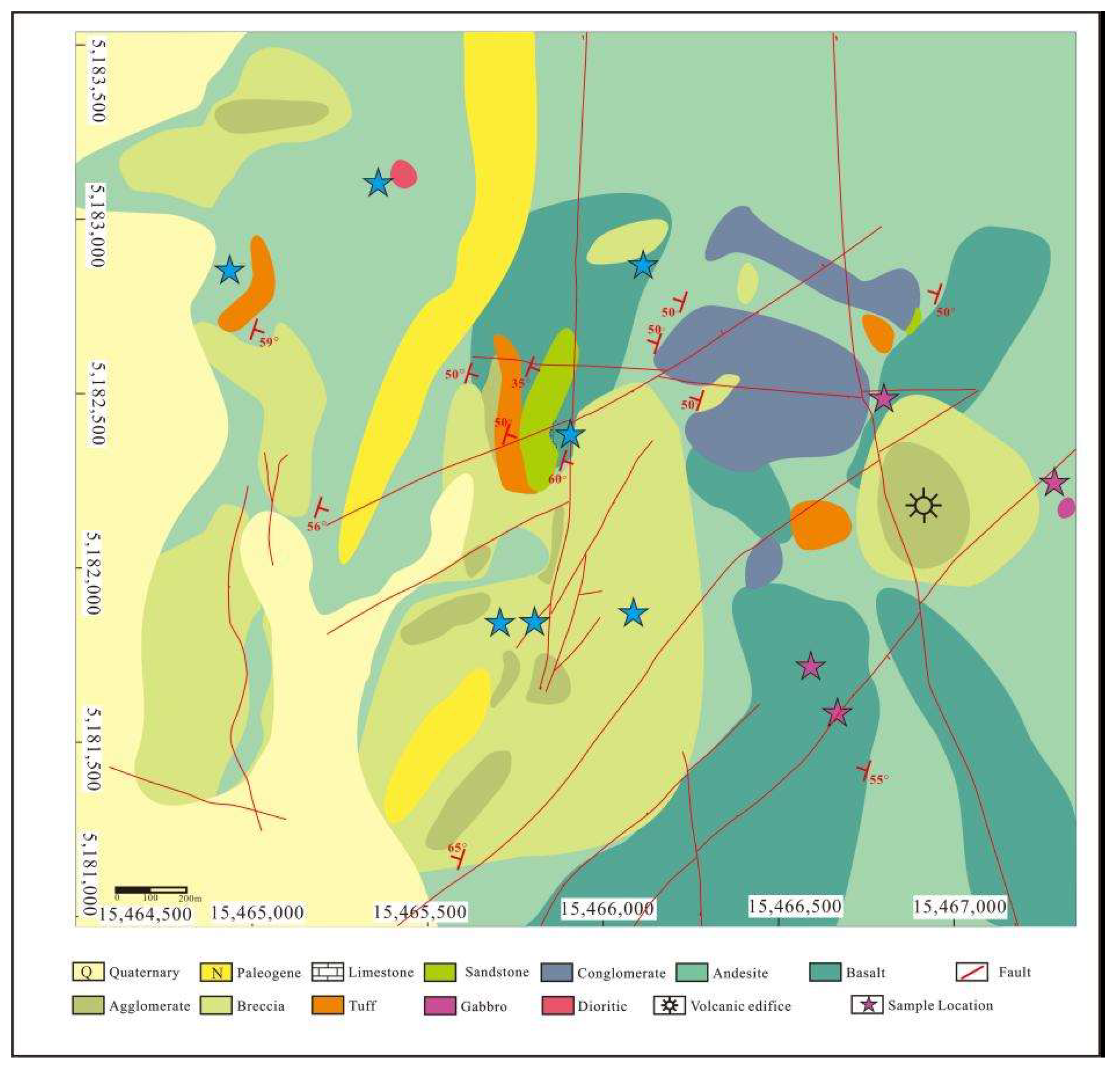


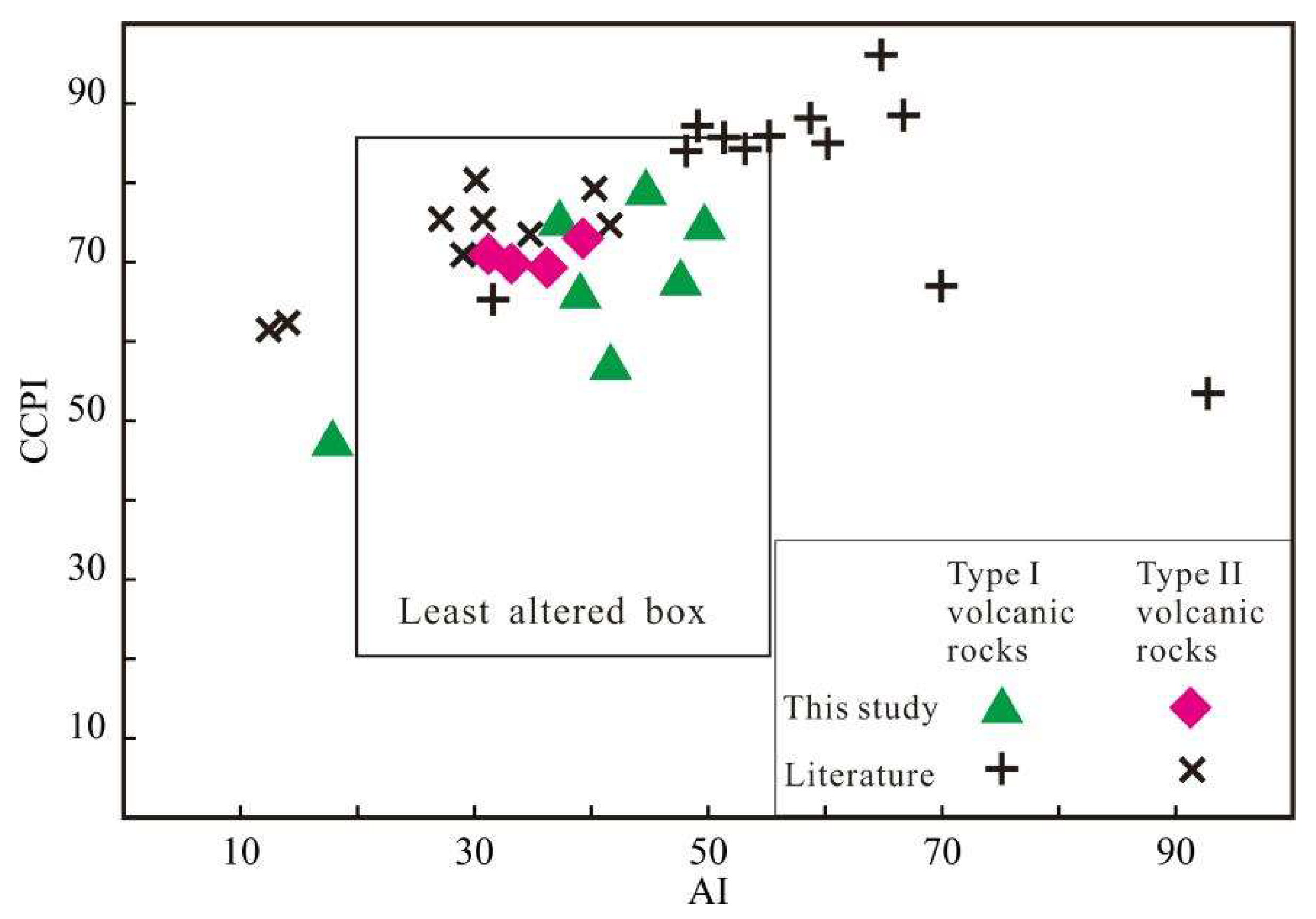
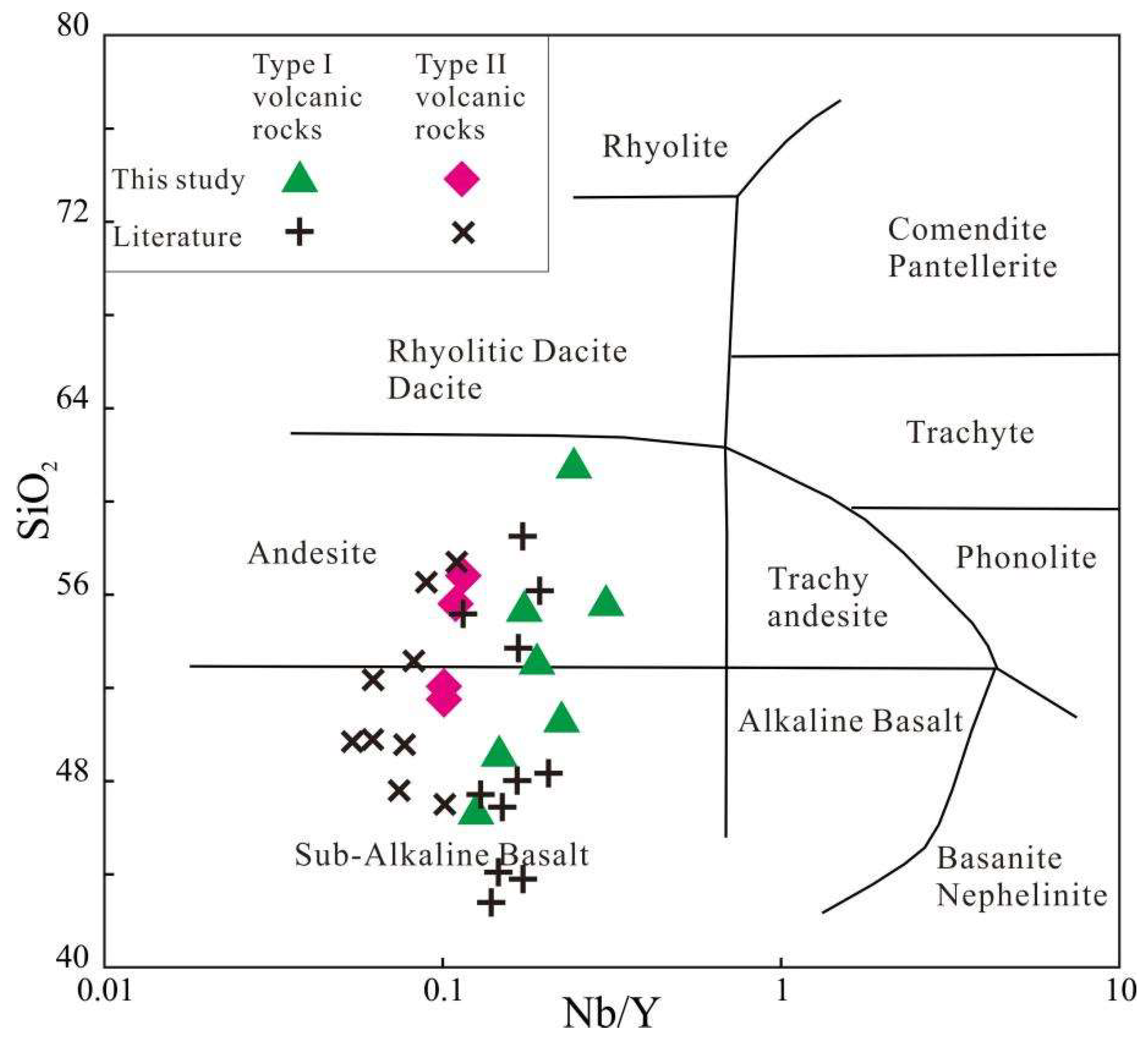
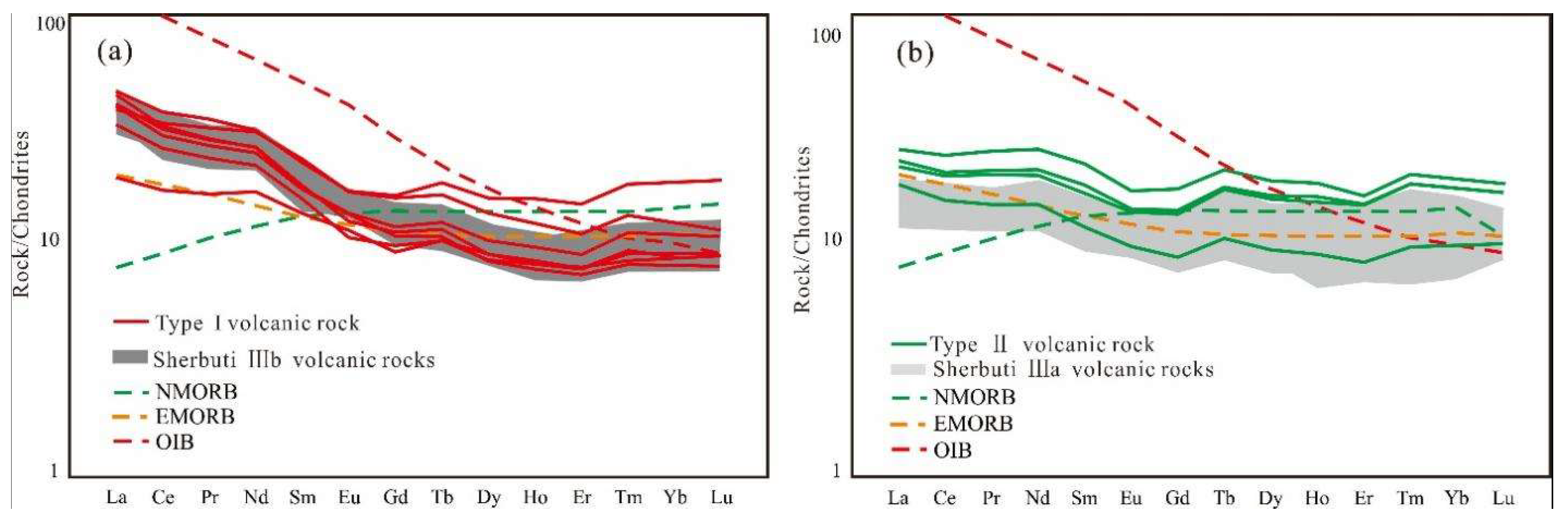

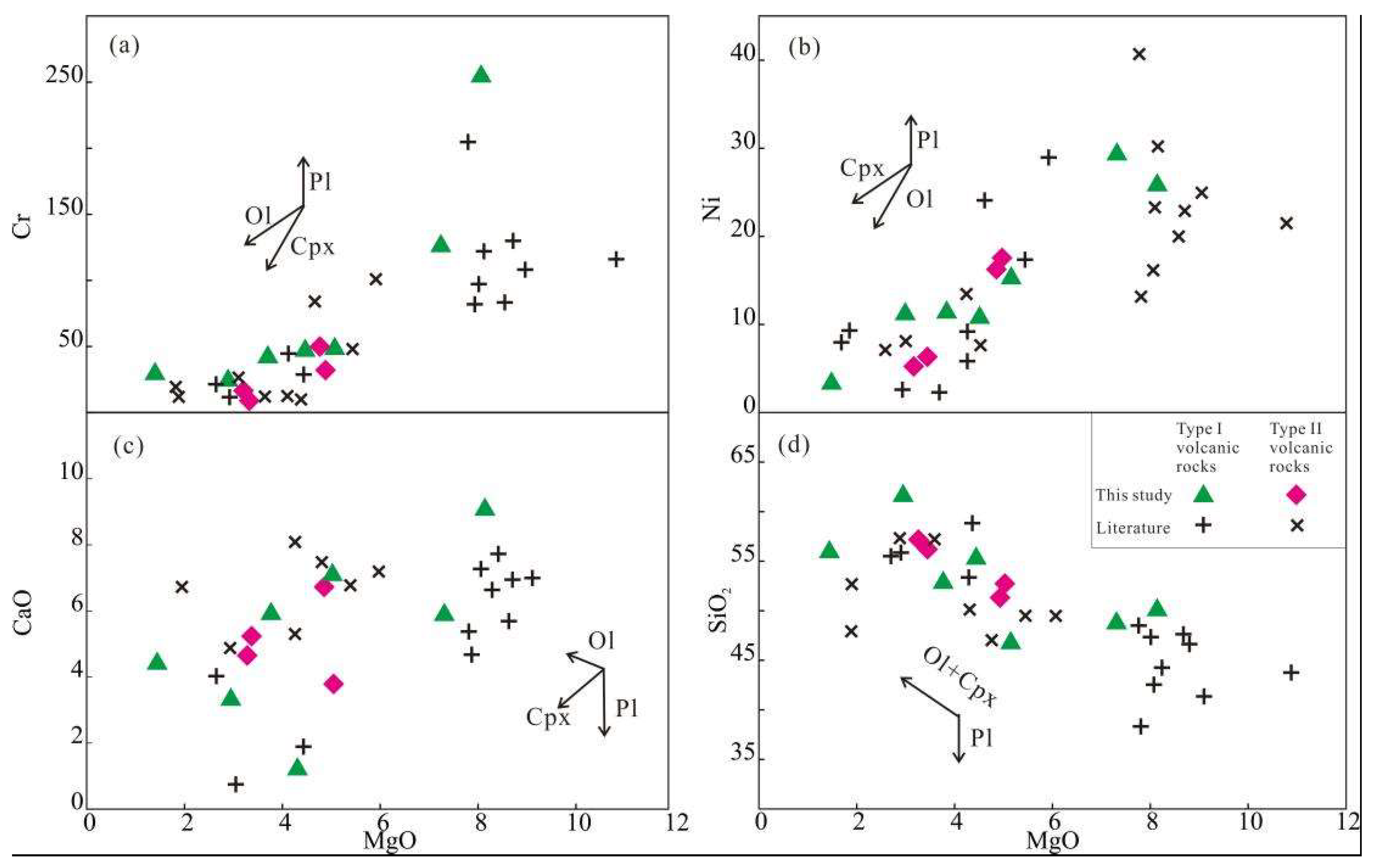
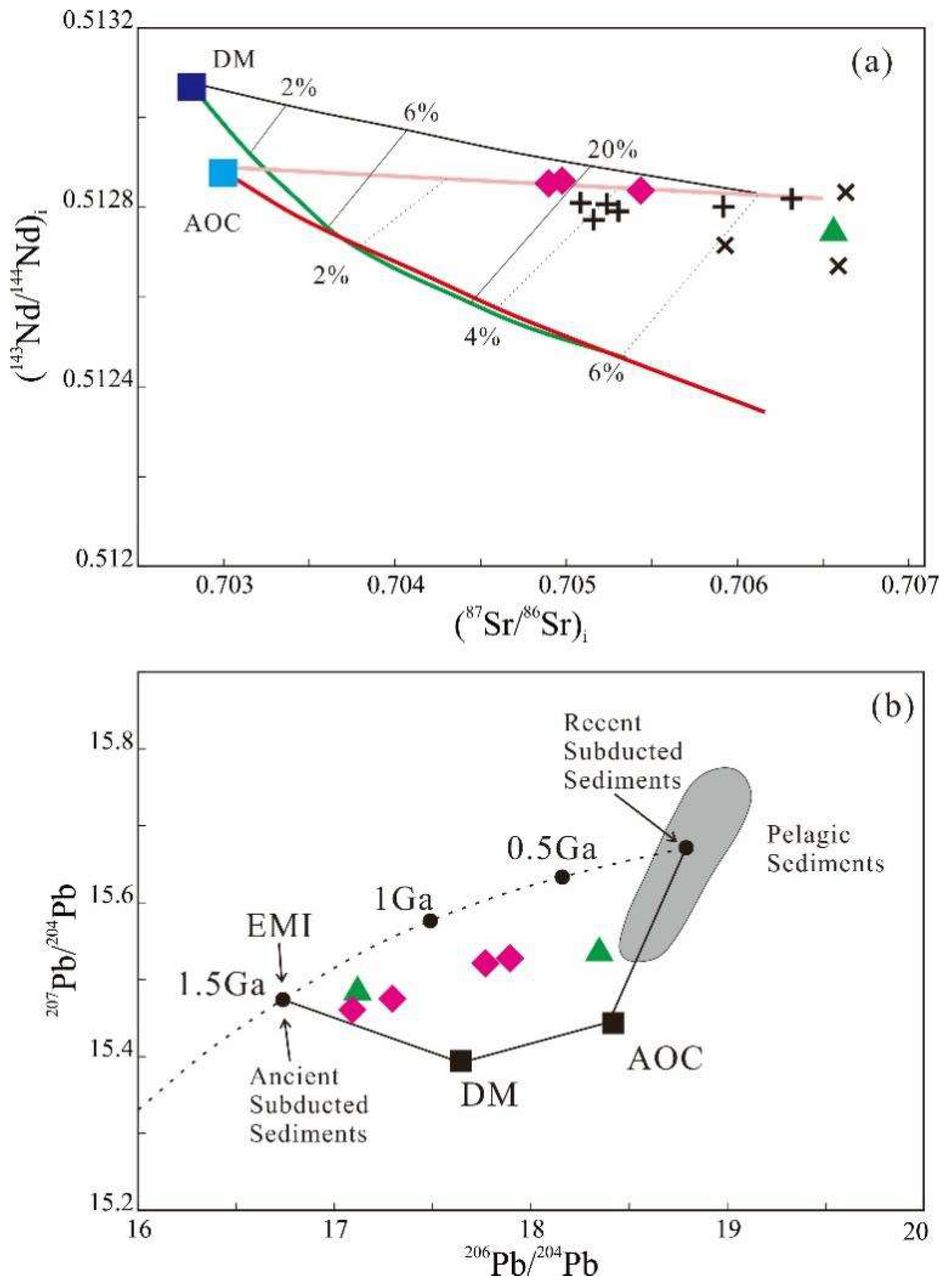
| Rock Sample | Type I Volcanic Rock | Type II Volcanic Rock | |||||||||
|---|---|---|---|---|---|---|---|---|---|---|---|
| Basalt | Basalt | Basalt | Basalt | Basalt | Andesite | Andesite | Basalt | Andesite | Andesite | Andesite | |
| HG17-46 | 15BHG45 | 15HG152 | HG2-11 | 15BHG129 | HG17-43 | HG17-2 | 15HG125 | 15HG74-2 | 15HG127 | 15HG76 | |
| SiO2 | 55.46 | 50.54 | 46.94 | 49.22 | 53.02 | 61.79 | 55.64 | 51.7 | 56.7 | 52.26 | 56.21 |
| TiO2 | 0.65 | 0.6 | 0.63 | 0.92 | 0.67 | 0.62 | 0.51 | 1.12 | 0.78 | 0.87 | 0.75 |
| Al2O3 | 16.58 | 13.35 | 21.23 | 15.84 | 16.15 | 15.73 | 17.41 | 17.44 | 17.73 | 15.1 | 17.44 |
| Fe2O3 | 8.38 | 3.01 | 4.48 | 2.27 | 4.19 | 4.36 | 3.59 | 5.96 | 4.4 | 4.39 | 3.84 |
| FeO | 1.77 | 6.49 | 4.68 | 7.28 | 5.06 | 1.55 | 2.93 | 4.17 | 4.14 | 6.1 | 4.1 |
| MnO | 0.11 | 0.18 | 0.14 | 0.28 | 0.15 | 0.1 | 0.14 | 0.18 | 0.15 | 0.19 | 0.15 |
| MgO | 4.51 | 8.14 | 5.12 | 7.31 | 3.74 | 2.92 | 1.51 | 4.95 | 3.26 | 4.93 | 3.35 |
| CaO | 1.32 | 8.95 | 7.09 | 5.88 | 5.97 | 3.23 | 4.32 | 3.79 | 4.91 | 6.84 | 5.35 |
| Na2O | 5.45 | 3.14 | 3.59 | 3.68 | 4.08 | 4.29 | 7.87 | 5.91 | 4.27 | 3.56 | 4 |
| K2O | 1.65 | 1.62 | 1.07 | 2.13 | 2.7 | 2.45 | 1.14 | 0.84 | 1.13 | 1.8 | 0.89 |
| P2O5 | 0.29 | 0.26 | 0.13 | 0.29 | 0.27 | 0.31 | 0.32 | 0.19 | 0.14 | 0.15 | 0.14 |
| LOI | 3.76 | 2.66 | 3.96 | 3.96 | 3.3 | 2.6 | 4.3 | 3.36 | 2.08 | 2.58 | 2.46 |
| TOTAL | 99.92 | 98.94 | 99.06 | 99.06 | 99.30 | 99.95 | 99.68 | 99.61 | 99.69 | 98.77 | 98.68 |
| Mg # | 0.82 | 0.69 | 0.66 | 0.64 | 0.57 | 0.77 | 0.48 | 0.68 | 0.58 | 0.59 | 0.59 |
| Cr | 46.8 | 255 | 48.2 | 126 | 41.9 | 20.6 | 25.6 | 50.6 | 5.29 | 32.1 | 5.25 |
| Co | 29.9 | 37.8 | 32.1 | 46.6 | 34.5 | 18.3 | 18.8 | 33.3 | 25.7 | 27.5 | 23.4 |
| Ni | 11.3 | 25.8 | 15.8 | 29.2 | 11.9 | 11.4 | 3.52 | 16.8 | 5.24 | 16.1 | 5.55 |
| Ga | 15.3 | 14.3 | 19.4 | 16.3 | 17.4 | 12.4 | 16.8 | 17.5 | 19.9 | 14 | 18.7 |
| Rb | 22.1 | 34.2 | 11.4 | 40.2 | 32.9 | 43.7 | 11.2 | 10.9 | 11.6 | 16.8 | 8 |
| Sr | 353 | 306 | 626 | 483 | 659 | 516 | 214 | 678 | 443 | 307 | 440 |
| Y | 15.7 | 15.5 | 16.5 | 24.4 | 19.8 | 16.3 | 32.5 | 36.5 | 31.3 | 18.2 | 30.1 |
| Nb | 4.49 | 3.48 | 2.07 | 3.44 | 3.76 | 4.21 | 5.35 | 3.68 | 3.5 | 1.82 | 3.3 |
| Cs | 0.41 | 0.44 | 0.55 | 1.03 | 0.56 | 0.9 | 0.09 | 0.54 | 0.25 | 0.61 | 0.26 |
| Ba | 312 | 251 | 394 | 698 | 520 | 461 | 196 | 414 | 508 | 370 | 375 |
| La | 10.4 | 12.5 | 6.14 | 12.1 | 14 | 12.8 | 14.5 | 8.1 | 7.24 | 5.71 | 6.82 |
| Ce | 21.4 | 24.3 | 14.1 | 27.5 | 26.7 | 25.9 | 30.7 | 19.9 | 16.8 | 12.7 | 16.2 |
| Pr | 2.93 | 3.32 | 2.05 | 3.96 | 3.56 | 3.51 | 4.32 | 3.13 | 2.58 | 1.84 | 2.48 |
| Nd | 13.4 | 15.2 | 10.3 | 18.7 | 16 | 16.1 | 19 | 15.7 | 12.8 | 9.06 | 12.1 |
| Sm | 3.12 | 3.42 | 2.7 | 4.64 | 3.47 | 3.56 | 4.47 | 4.41 | 3.57 | 2.35 | 3.29 |
| Eu | 0.8 | 1.01 | 0.86 | 1.26 | 1.02 | 0.94 | 1.27 | 1.27 | 1.06 | 0.73 | 1.03 |
| Gd | 2.6 | 2.86 | 2.44 | 4.18 | 3.14 | 2.97 | 4.28 | 4.56 | 3.69 | 2.31 | 3.55 |
| Tb | 0.5 | 0.52 | 0.5 | 0.79 | 0.6 | 0.56 | 0.89 | 1.01 | 0.85 | 0.51 | 0.83 |
| Dy | 2.8 | 2.77 | 2.97 | 4.47 | 3.4 | 2.97 | 5.19 | 6.15 | 5.31 | 3.09 | 5.13 |
| Ho | 0.6 | 0.57 | 0.62 | 0.9 | 0.71 | 0.6 | 1.15 | 1.34 | 1.17 | 0.66 | 1.11 |
| Er | 1.67 | 1.58 | 1.68 | 2.37 | 1.93 | 1.7 | 3.19 | 3.45 | 3.18 | 1.78 | 3.15 |
| Tm | 0.3 | 0.27 | 0.31 | 0.44 | 0.37 | 0.28 | 0.6 | 0.66 | 0.6 | 0.32 | 0.6 |
| Yb | 1.97 | 1.71 | 1.87 | 2.61 | 2.31 | 1.86 | 3.98 | 4.11 | 3.77 | 2.1 | 3.7 |
| Lu | 0.29 | 0.25 | 0.27 | 0.38 | 0.35 | 0.28 | 0.62 | 0.61 | 0.55 | 0.32 | 0.58 |
| Ta | 0.61 | 0.43 | 0.32 | 0.29 | 0.31 | 0.38 | 0.64 | 0.4 | 0.4 | 0.23 | 0.36 |
| Pb | 3.23 | 1.94 | 2.91 | 1.46 | 7.64 | 5.18 | 2.16 | 4.75 | 3.33 | 4.42 | 3.64 |
| Th | 2.39 | 1.88 | 0.94 | 1.65 | 2.5 | 2.71 | 2.4 | 1.03 | 0.96 | 0.95 | 0.91 |
| U | 3.82 | 0.99 | 0.69 | 0.98 | 1.72 | 2.05 | 1.33 | 0.82 | 1.18 | 0.74 | 1.02 |
| Zr | 57.2 | 45.1 | 47.4 | 67.5 | 59.2 | 57.6 | 121 | 108 | 111 | 56.4 | 107 |
| Hf | 1.8 | 1.49 | 1.58 | 2.15 | 1.91 | 1.9 | 3.34 | 3.35 | 3.43 | 1.83 | 3.28 |
| Th/Nb | 0.53 | 0.54 | 0.46 | 0.48 | 0.66 | 0.64 | 0.45 | 0.28 | 0.27 | 0.52 | 0.27 |
| Rb/Y | 1.41 | 2.21 | 0.69 | 1.65 | 1.66 | 2.68 | 0.34 | 0.3 | 0.37 | 0.92 | 0.27 |
| Nb/Zr | 0.08 | 0.08 | 0.04 | 0.05 | 0.06 | 0.07 | 0.04 | 0.03 | 0.03 | 0.03 | 0.03 |
| Zr/Nb | 12.74 | 12.96 | 22.9 | 19.62 | 15.74 | 13.68 | 22.62 | 29.35 | 31.71 | 30.99 | 32.42 |
| (La/Sm)N | 3.33 | 3.65 | 2.27 | 2.61 | 4.03 | 3.6 | 3.24 | 1.84 | 2.03 | 2.43 | 2.07 |
| (La/Yb)N | 5.28 | 7.31 | 3.28 | 4.64 | 6.06 | 6.88 | 3.64 | 1.97 | 1.92 | 2.72 | 1.84 |
| (Gd/Yb)N | 1.32 | 1.67 | 1.3 | 1.6 | 1.36 | 1.6 | 1.08 | 1.11 | 0.98 | 1.1 | 0.96 |
| Th/Yb | 1.21 | 1.1 | 0.5 | 0.63 | 1.08 | 1.46 | 0.6 | 0.25 | 0.25 | 0.45 | 0.24 |
| Nb/Yb | 2.28 | 2.04 | 1.11 | 1.32 | 1.63 | 2.26 | 1.34 | 0.9 | 0.93 | 0.87 | 0.89 |
| Sample Number | Rock Type | Rb (×10−6) | Sr (×10−6) | 87Rb/86Sr | (87Sr/86Sr)m | 2δ(×10−6) | (87Sr/86Sr)i | εSr(t) | Sm (×10−6) | Nd (×10−6) | 147Sm/144Nd | (143Nd/144Nd)m | 2δ(×10−6) | (143Nd/144Nd)i | εNd(t) | TDM |
|---|---|---|---|---|---|---|---|---|---|---|---|---|---|---|---|---|
| 15BHG45 | Type I volcanic rock | 32.46 | 324.8 | 0.2893 | 0.707082 | 14 | 0.705227 | 18.441707 | 3.268 | 14.19 | 0.1394 | 0.512805 | 8 | 0.512394 | 6.55 | 709 |
| 15HG127 | Type II volcanic rock | 20.13 | 419.3 | 0.1390 | 0.705466 | 10 | 0.704575 | 9.158643 | 2.838 | 10.51 | 0.1635 | 0.512876 | 11 | 0.512394 | 6.55 | 833 |
| 15HG74-2 | Type II volcanic rock | 13.65 | 601 | 0.0657 | 0.705048 | 12 | 0.704626 | 9.882972 | 4.302 | 14.91 | 0.1747 | 0.512905 | 8 | 0.512391 | 6.49 | 955 |
| 15HG76 | Type II volcanic rock | 7.811 | 488.7 | 0.0463 | 0.704924 | 13 | 0.704628 | 9.907471 | 3.366 | 11.7 | 0.1742 | 0.512901 | 9 | 0.512387 | 6.42 | 963 |
| 15HG17-43 | Type I volcanic rock | 7.385 | 565.6 | 0.0378 | 0.706602 | 12 | 0.706359 | 34.504278 | 3.345 | 14.94 | 0.1356 | 0.512796 | 8 | 0.512397 | 6.61 | 690 |
| Sample Number | Rock Type | U | Th | Pb | 238U/204Pb | 235U/204Pb | 232Th/204Pb | (206Pb/204Pb)m | (207Pb/204Pb)m | (208Pb/204Pb)m | (206Pb/204Pb)i | (207Pb/204Pb)i | (208Pb/204Pb)i |
|---|---|---|---|---|---|---|---|---|---|---|---|---|---|
| 15BHG45 | Type I volcanic rock | 0.99 | 1.88 | 1.94 | 36.186 | 0.262 | 69.219 | 20.964 | 15.681 | 39.549 | 18.348 | 15.535 | 37.991 |
| 15HG127 | Type Ⅱ volcanic rock | 0.743 | 0.948 | 4.42 | 11.920 | 0.086 | 15.320 | 18.756 | 15.576 | 38.159 | 17.894 | 15.528 | 37.814 |
| 15HG125 | Type Ⅱ volcanic rock | 0.824 | 1.03 | 4.75 | 12.301 | 0.089 | 15.489 | 18.657 | 15.571 | 38.255 | 17.768 | 15.521 | 37.906 |
| 15HG74-2 | Type Ⅱ volcanic rock | 1.18 | 0.958 | 3.33 | 25.128 | 0.182 | 20.549 | 18.869 | 15.556 | 38.163 | 17.052 | 15.454 | 37.700 |
| 15HG76 | Type Ⅱ volcanic rock | 1.02 | 0.906 | 3.64 | 19.871 | 0.144 | 17.779 | 18.715 | 15.553 | 38.132 | 17.278 | 15.473 | 37.732 |
| HG17-43 | Type I volcanic rock | 2.05 | 2.71 | 5.18 | 28.063 | 0.204 | 37.369 | 19.159 | 15.573 | 38.449 | 17.130 | 15.460 | 37.608 |
Disclaimer/Publisher’s Note: The statements, opinions and data contained in all publications are solely those of the individual author(s) and contributor(s) and not of MDPI and/or the editor(s). MDPI and/or the editor(s) disclaim responsibility for any injury to people or property resulting from any ideas, methods, instructions or products referred to in the content. |
© 2023 by the authors. Licensee MDPI, Basel, Switzerland. This article is an open access article distributed under the terms and conditions of the Creative Commons Attribution (CC BY) license (https://creativecommons.org/licenses/by/4.0/).
Share and Cite
Sun, J.; Li, N.; Dong, C.; Ren, Y. Geochemical Features of Volcanic Rocks from the Shaerbuti Mountain Complex, West Junggar, Xinjiang, China: Implications for Recycling of Materials. Minerals 2023, 13, 75. https://doi.org/10.3390/min13010075
Sun J, Li N, Dong C, Ren Y. Geochemical Features of Volcanic Rocks from the Shaerbuti Mountain Complex, West Junggar, Xinjiang, China: Implications for Recycling of Materials. Minerals. 2023; 13(1):75. https://doi.org/10.3390/min13010075
Chicago/Turabian StyleSun, Jinheng, Ni Li, Cheng Dong, and Yanhong Ren. 2023. "Geochemical Features of Volcanic Rocks from the Shaerbuti Mountain Complex, West Junggar, Xinjiang, China: Implications for Recycling of Materials" Minerals 13, no. 1: 75. https://doi.org/10.3390/min13010075
APA StyleSun, J., Li, N., Dong, C., & Ren, Y. (2023). Geochemical Features of Volcanic Rocks from the Shaerbuti Mountain Complex, West Junggar, Xinjiang, China: Implications for Recycling of Materials. Minerals, 13(1), 75. https://doi.org/10.3390/min13010075





